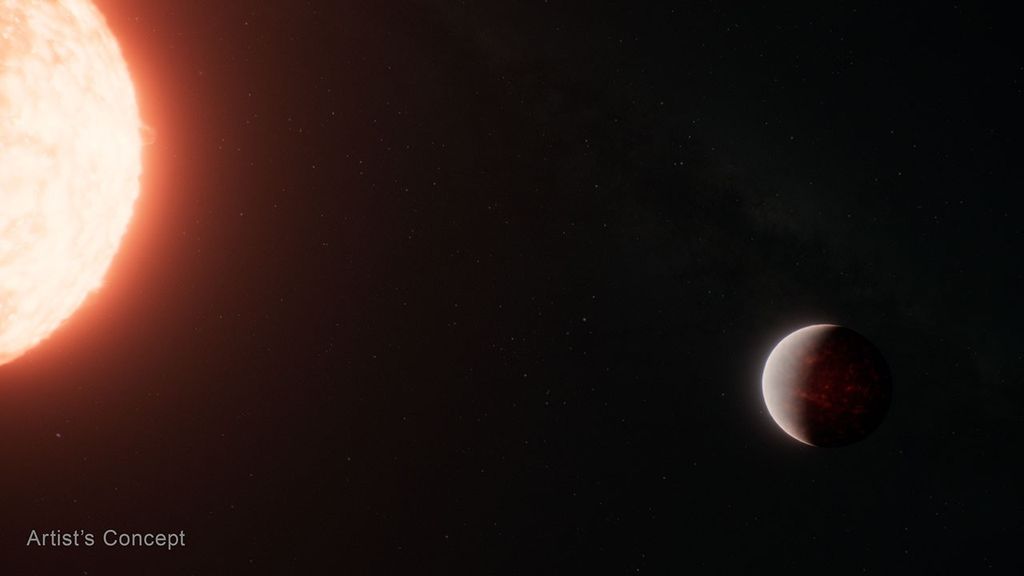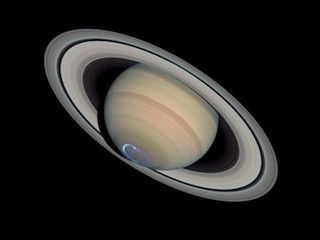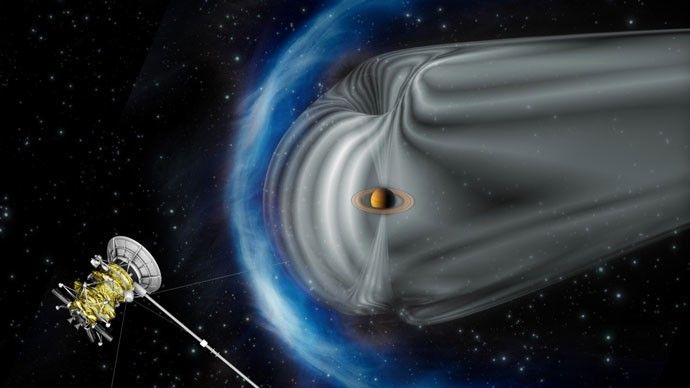Saturn's Magnetosphere: Overview
Before Cassini, scientists had little information about Saturn’s magnetosphere because magnetic fields are invisible and are best studied from within. Cassini studied Saturn's magnetosphere by mapping the magnetic field, studying the flow of excited gases under its influence and observing how it affects Saturn’s auroras. The results have provided powerful insights about how Saturn's inner workings affect the planet's atmosphere and the space around it.
Key Points
◆ Saturn is surrounded by a giant magnetic bubble: its magnetosphere.
◆ Material blasted into space by Enceladus feeds Saturn’s giant E ring and is a major source of material (plasma) fueling Saturn’s magnetosphere.
◆ Saturn's rotation rate remains a mystery, and Cassini showed it to be far more complicated than expected.
◆ Forces deep inside Saturn create the giant magnetic bubble around the planet, called the magnetosphere, which exerts a powerful influence on the space environment near the planet. Saturn's magnetic field is created as material cycles deep within the planet's fluid interior.
Outside Saturn's magnetosphere, a million-mile-per-hour flow of electrically charged particles (electrons and ions) from the sun, called the solar wind, spreads out through the solar system. When the solar wind encounters Saturn's own magnetic field, the protective bubble of Saturn’s magnetosphere forms. Outside the planet's magnetosphere, the Sun's magnetic forces dominate, while inside the planet's protective bubble, the magnetic forces of Saturn reign.
In a similar way, Earth's magnetic field creates a much smaller magnetosphere that protects us from harmful particles emitted by the sun and other space phenomena.
Measurements from Cassini have totally changed our understanding of Saturn’s magnetosphere, yet many questions still remain.

Marcia Burton
Magnetospheres and plasma science investigation scientist at NASA’s Jet Propulsion Laboratory
Saturn's magnetic field has north and south poles, like those on a bar magnet, and the field rotates with the planet. On Jupiter and Earth, the magnetic fields are slightly tilted with respect to the from the planets' rotation axes – this tilt is the reason we say compass needles point to "magnetic north" rather than true north. But Saturn's magnetic field is almost perfectly aligned with the planet's rotation.
The structure and strength of the magnetic field at different locations within the magnetosphere can tell us about Saturn's interior structure and reveal unseen details about how the planet interacts with the solar wind that fills interplanetary space.
Magnetic fields themselves are invisible, but we can study them with a diverse set of instruments, like those that were on Cassini. Before the Cassini spacecraft arrived at Saturn, scientists had only brief glimpses at what Saturn's magnetosphere was like. The knowledge was based on flybys by the Pioneer and Voyager spacecraft in the late 1970s and early 1980s. But these spacecraft only spent a matter of days in Saturn's magnetosphere.
Equipped with a much more capable suite of instruments and ample time in orbit around Saturn, Cassini confirmed some of the earlier measurements but also revealed some remarkable differences. For example, Cassini’s cameras took images of auroras formed by charged particles slamming into the planet's upper atmosphere. And by measuring the flow of charged particles around the spacecraft, Cassini observed how Saturn's rings and moons release material into the magnetosphere, interacting with and modifying it.
“Fields and particles instruments on the Cassini spacecraft have revealed that Enceladus powers a huge plume of water ice particles and dust grains, the dominant source of Saturn’s E ring,” said Marcia Burton, magnetospheres and plasma science investigation scientist at NASA’s Jet Propulsion Laboratory. “Our first indication of the plume's presence was from observations of how Saturn's magnetic field was deflected.”
In addition to their magnetic effects, magnetospheres produce radio waves. Saturn's magnetic field is far weaker than Jupiter's, and unlike the more intense Jovian radio emissions, Saturn's radio signals are not powerful enough to be detected from Earth. Cassini and previous spacecraft that visited Saturn measured a type of radio emissions that scientists had expected would reveal the rotation period of Saturn's magnetic field. This rotation rate was thought to be the true length of the planet's day, since gas giants have no solid surface and their cloud bands move at various speeds.
Puzzlingly, the rotation rate Cassini measured was slower than that measured 25 years earlier by the Voyager spacecraft, and that rate varied during Cassini's 13 years orbiting Saturn. Since an actual slowing of the giant planet's rotation was highly unlikely, scientists had a mystery on their hands. Various ideas have been proposed; some scientists suggested that material blasted into space by the geologic activity on Enceladus was to blame. Apparently Saturn's magnetic field is slowed down as it drags through the ring of particles that litter the orbit of Enceladus. Other scientists have suggested that this strange signature originates in the upper atmosphere or ionosphere.
“Measurements from Cassini have totally changed our understanding of Saturn’s magnetosphere, yet many questions still remain,” said Burton.
Titan Outside the Protective Bubble
Titan spends about 95% of the time within Saturn's magnetosphere. But during a Cassini flyby on Dec. 1, 2013, the giant moon happened to be on the sunward side of Saturn when a powerful outburst of solar activity reached the planet. The strong surge in the solar wind so compressed the Sun-facing side of Saturn's magnetosphere that the bubble's outer edge was pushed inside the orbit of Titan. This left the moon exposed to, and unprotected from, the raging stream of energetic solar particles.
First Look
Saturn's magnetosphere was seen for the first time in this image taken by the Cassini spacecraft on June 21, 2004. A magnetosphere is a magnetic envelope of charged particles that surrounds some planets, including Earth. It is invisible to the human eye, but Cassini's Magnetospheric Imaging Instrument was able to detect the hydrogen atoms (represented in red) that escape it.
































